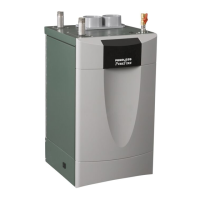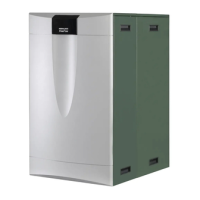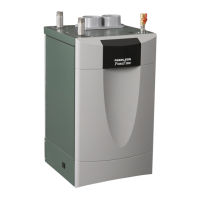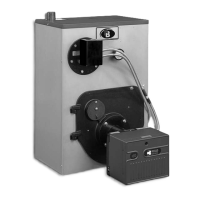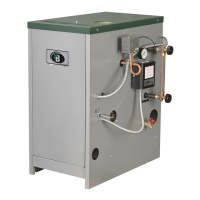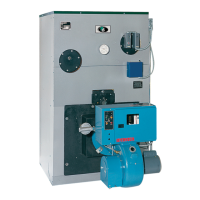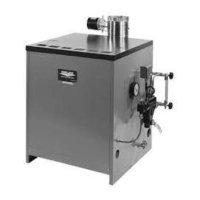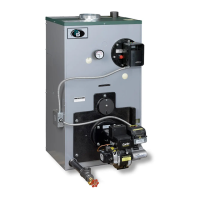What to check if my PEERLESS PureFire PF-110 shows a low water error?
- Rraymond17Aug 26, 2025
Check the boiler water level, low water cut-off, and harness. If a LWCO is not used, a jumper should be placed between terminals #9 and #10, LWCO Contact.
What to check if my PEERLESS PureFire PF-110 shows a low water error?
Check the boiler water level, low water cut-off, and harness. If a LWCO is not used, a jumper should be placed between terminals #9 and #10, LWCO Contact.
How do I fix a blocked condensate drain on my PEERLESS Boiler?
If your PEERLESS Boiler shows a 'BLOCKED CONDENSATE DRAIN' error, check the condensate tanks, hoses, condensate switch, and harness.
Follow instructions in order for safety & minimal interference.
Defines DANGER, WARNING, CAUTION, NOTICE boxes used throughout the manual.
Boiler assembly, inspection, storage, and reading instructions before installation.
Compliance with state/local codes and ASME/ANSI standards for boiler installation.
Specifies minimum clearances for boiler installation and importance of no carpeting.
Requirements for combustion and ventilation air, including methods for calculating volume.
Prepare sketches for layout to minimize interferences with existing equipment.
Boiler installation area requirements, support for piping, and leveling.
Instructions for installing the boiler using the wall mounting bracket kit.
Guidance for floor standing installations, including leveling feet.
Install venting system per codes and standards; avoid contaminated air sources.
Lists approved materials for vent pipe and fittings; use only specified components.
Guidance on locating vent/air intake pipes, including clearance and condensate plume.
Tables and guidance for sizing exhaust vent and air intake pipes based on boiler model and fittings.
Connect exhaust and air intake pipes, seal joints, ensure proper slope and support.
Instructions for drilling a hole in the vent pipe for combustion analysis.
Steps for removing an existing boiler from a common venting system.
System requirements, cleaning, protection from water, and water quality for hydronic systems.
Boiler operation in closed-loop systems, minimum pressure, and flow rates.
Description of key system components like pressure/temperature gauges, air eliminators, and expansion tanks.
Diagrams and explanations for single/multiple boiler piping configurations.
Guidance on using glycol solutions for freeze protection, including mixing and water quality.
System piping for chiller operation and heating coils in forced air systems.
Fuel piping to comply with codes, supply gas for all appliances, and natural gas/propane specs.
Determining required gas flow rate and pipe capacity based on pressure drop.
Installing piping, sediment trap, and ensuring access.
Purging gas lines, checking supply pressure, and handling gas valve.
Adjusting gas valve for CO2 settings and emissions.
Disposal of condensate per local codes and instructions for proper operation.
Design for preventing backup, trapping condensate, and neutralizing acidity.
Approved materials for condensate piping; avoid steel/brass due to acidic condensate.
Sizing requirements for condensate connection and tubing.
Connecting drain piping, ensuring slope, and using condensate pumps.
Wiring to comply with local codes and National Electrical Code.
Wiring diagrams for low voltage and line voltage connections for different boiler models.
Typical wiring diagram for a circulator zone relay.
Schematic and list of internal wiring components for boiler control.
Boiler control functions, safety features, and modes for heating and hot water.
Graphical representation and detailed steps of the boiler's ignition sequence.
Control settings for installation location, vent material, freeze protection, and safety functions.
Overview and detailed descriptions of various central heating modes.
Overview and detailed descriptions of domestic hot water modes and priority.
Setting up service reminders based on hours, cycles, or date.
Using system test mode for setup, troubleshooting, and obtaining combustion readings.
Viewing boiler status, sensor readings, and fault history.
Typical resistance values for boiler sensors at different temperatures.
Setting up and operating multiple boilers in a cascade system.
Restoring factory or site default settings for the boiler control.
Initial checks for water, gas, electricity, and proper installation before startup.
Filling the boiler with water, purging air, and checking for leaks.
Verifying gas supply pressure and performing leak checks.
Testing boiler shutdown at setpoint, combustion readings, and fan speeds.
Step-by-step instructions for safely lighting and operating the boiler.
Understanding and correcting blocking errors displayed by the control.
Understanding and correcting locking errors that require a control reset.
Information on error messages when using a cascade system.
Identifying and correcting sensor and system errors displayed as warnings.
Routine observations and checks for the boiler while in operation.
Flushing the float-type low-water cut-off.
Annual inspection procedures for safety relief valve, limits, and burner.
Procedures for removing and cleaning condensate tanks and hoses.
Steps for cleaning the heat exchanger coils using chemical solutions.
